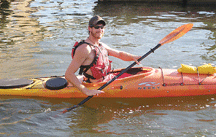
|
Volume 16, Issue 41 - October 9 - October 15, 2008
|
|
Columns |
Getting Around
 |
Greg Williams, top, prefers biking, walking and sailing to driving his car around Annapolois.Ian Smith, above, has been kayaking since age 9. He’ll often paddle across the Bay to Hemingway’s for lunch. |
 |
Stories on the Move
by Erica Stratton
First Steps in Taking Our Feet off the Gas Pedal
Biking, walking and sailing are Greg Williams’ favorite ways of getting around. A futurist, he thinks past himself to the bigger picture: “It should be like Venice around here,” says Williams, who works as a sailboat rigger. “Not like D.C.”
Williams dreams of a public system of water transport for Maryland’s capital.
“We live in one of the coolest places in the world, and we don’t use it well enough,” he says, sketching a map of the inlets that surround Annapolis. In downtown Annapolis, many of the roads are narrow, and parking is almost impossible. Moving traffic from the roads to the waterways would take the pressure off getting around.
How to do it?
The fleet of water taxis could be increased, but that would also increase fuel emissions. Cleaner, simpler and quicker is the kayak — with docking racks at all public docks.
“A lot of kayaks remain in yards,” says Ian Smith, a paddling consultant at Annapolis Canoe and Kayak. A biology major, Smith’s been kayaking since the age of nine and paddles to work every day. He’ll often paddle across the Bay to Hemingway’s for lunch, he says, “have a few beers and paddle back.”
Getting around by kayak? Is it feasible? If you live in or near a town — Annapolis and even the Beaches or Solomons.
“If you can kayak to downtown, you can satisfy most of your needs,” Smith says. Like Williams, Smith walks, floats or bikes to almost everywhere he needs to go. “I haven’t used my car all summer,” he says. But he hasn’t gotten rid of it, either.
More broadly feasible is a mix of methods. Horse-drawn carriage, solar buggy, Segway or Powerisers might not be your method of choice. But you could add a bit of walking, biking or bussing to your car routine.
A more eco-friendly Annapolis may look less like a floating city and more a melding of, say, Venice and Amsterdam, where many people get around by bikes. It would take time to change the city to meet such new needs. Even before kayak racks are installed and better bike lanes built (both Williams and Smith have complained about the lack of both), you can change. Taken together, our individual small steps are a beginning.
A kayak can cost from $360 to $4,000, with an average of about $800. Smith’s kayak, which has survived getting run over by a car, cost $1,699.